Name George Beadle | Role Scientist Fields Genetics | |
 | ||
Born George Wells BeadleOctober 22, 1903Wahoo, Nebraska, United States ( 1903-10-22 ) Institutions California Institute of TechnologyUniversity of ChicagoHarvard UniversityStanford University Alma mater University of NebraskaCornell University Thesis Genetical and Cytological Studies of Mendelian Asynapsis in Zea mays (1930) Known for One gene-one enzyme hypothesisGene regulation of biochemical events within cells Died June 9, 1989, Chicago, Illinois, United States Books The Language of Life, Genetics and Modern Biology Similar People Edward Lawrie Tatum, Alfred Sturtevant, Barbara McClintock, Alfred Hershey, Martha Chase | ||
Doctoral advisor Franklin D. Keim | ||
Edward Tatum and George Beadle Experiment | 1 Gene 1 Enzyme
George Wells Beadle (October 22, 1903 – June 9, 1989) was an American scientist in the field of genetics, and Nobel Prize in Physiology or Medicine Nobel laureate who with Edward Tatum discovered the role of genes in regulating biochemical events within cells in 1958.
Contents
- Edward Tatum and George Beadle Experiment 1 Gene 1 Enzyme
- What is George Beadle Explain George Beadle Define George Beadle Meaning of George Beadle
- Education and early life
- Career
- Awards and honors
- Personal life
- References

Beadle and Tatum's key experiments involved exposing the bread mold Neurospora crassa to x-rays, causing mutations. In a series of experiments, they showed that these mutations caused changes in specific enzymes involved in metabolic pathways. These experiments led them to propose a direct link between genes and enzymatic reactions, known as the One gene-one enzyme hypothesis.

What is George Beadle? Explain George Beadle, Define George Beadle, Meaning of George Beadle
Education and early life

George Wells Beadle was born in Wahoo, Nebraska. He was the son of Chauncey Elmer Beadle and Hattie Albro, who owned and operated a 40-acre (160,000 m2) farm nearby. George was educated at the Wahoo High School and might himself have become a farmer if one of his teachers at school had not directed his mind towards science and persuaded him to go to the College of Agriculture in Lincoln, Nebraska. In 1926 he took his Bachelor of Science degree at the University of Nebraska and subsequently worked for a year with Professor F.D. Keim, who was studying hybrid wheat. In 1927 he took his Master of Science degree, and Professor Keim secured for him a post as Teaching Assistant at Cornell University, where he worked, until 1931, with Professors R.A. Emerson and L.W. Sharp on Mendelian asynapsis in Zea mays. For this work he obtained, in 1931, his Doctor of Philosophy degree.
Career

In 1931 Beadle was awarded a National Research Council Fellowship at the California Institute of Technology at Pasadena, where he remained from 1931 until 1936. During this period he continued his work on Indian corn and began, in collaboration with Professors Theodosius Dobzhansky, S. Emerson, and Alfred Sturtevant, work on crossing-over in the fruit fly, Drosophila melanogaster.

In 1935 Beadle visited Paris for six months to work with Professor Boris Ephrussi at the Institut de Biologie physico-chimique. Together they began the study of the development of eye pigment in Drosophila which later led to the work on the biochemistry of the genetics of the fungus Neurospora for which Beadle and Edward Lawrie Tatum were together awarded the 1958 Nobel Prize for Physiology or Medicine.

In 1936 Beadle left the California Institute of Technology to become Assistant Professor of Genetics at Harvard University. A year later he was appointed Professor of Biology (Genetics) at Stanford University and there he remained for nine years, working for most of this period in collaboration with Tatum. In 1946 he returned to the California Institute of Technology as Professor of Biology and Chairman of the Division of Biology. Here he remained until January 1961 when he was elected Chancellor of the University of Chicago and, in the autumn of the same year, President of this University.
After retiring, Beadle undertook a remarkable experiment in maize genetics. In several laboratories he grew a series of Teosinte/Maize crosses. Then he crossed these progeny with each other. He looked for the rate of appearance of parent phenotypes among this second generation. The vast majority of these plants were intermediate between maize and Teosinte in their features, but about 1 in 500 of the plants were identical to either the parent maize or the parent teosinte. Using the mathematics of Mendelian genetics, he calculated that this showed a difference between maize and teosinte of about 5 or 6 genetic loci. This demonstration was so compelling that most scientists now agree that Teosinte is the wild progenitor of maize.
During his career, Beadle has received many honors. These include the Honorary Doctor of Science of the following Universities: Yale (1947), Nebraska (1949), Northwestern University (1952), Rutgers University (1954), Kenyon College (1955), Wesleyan University (1956), the University of Birmingham and the University of Oxford, England (1959), Pomona College (1961), and Lake Forest College (1962). In 1962 he was also given the honorary degree of LL.D. by the University of California, Los Angeles. He was elected a Fellow of the American Academy of Arts and Sciences in 1946. He also received the Lasker Award of the American Public Health Association (1950), the Dyer Award (1951), the Emil Christian Hansen Prize of Denmark (1953), the Albert Einstein Commemorative Award in Science (1958), the Nobel Prize in Physiology or Medicine 1958 with Edward Tatum and Joshua Lederberg, the National Award of the American Cancer Society (1959), and the Kimber Genetics Award of the National Academy of Sciences (1960).
Awards and honors
In addition to the Nobel Prize, Beadle received numerous other awards. Beadle was a member of several learned societies, among which the National Academy of Sciences (Chairman of Committee on Genetic Effects of Atomic Radiation), the Genetics Society of America (President in 1946), the American Association for the Advancement of Science (President in 1955), the American Cancer Society (Chairman of Scientific Advisory Council), the Royal Society of London, and the Danish Royal Academy of Science.
The George W. Beadle Award of the Genetics Society of America is named in his honor. George Beadle Middle School in Millard, Nebraska (Part of the Millard Public Schools district) was named after him. It opened in 2001. The Beadle Center, which houses the Department of Biochemistry at the University of Nebraska-Lincoln, is also named after George Beadle.
Personal life
Beadle was married twice. By his first wife he had a son, David, who now lives at The Hague, the Netherlands. His second wife, Muriel McClure (1915-1994), a well-known writer, was born in California. Beadle's chief hobbies were rockclimbing, skiing, and gardening. He was a member of FarmHouse Fraternity while at the University of Nebraska.
George Beadle died on June 9, 1989. He was an atheist.
